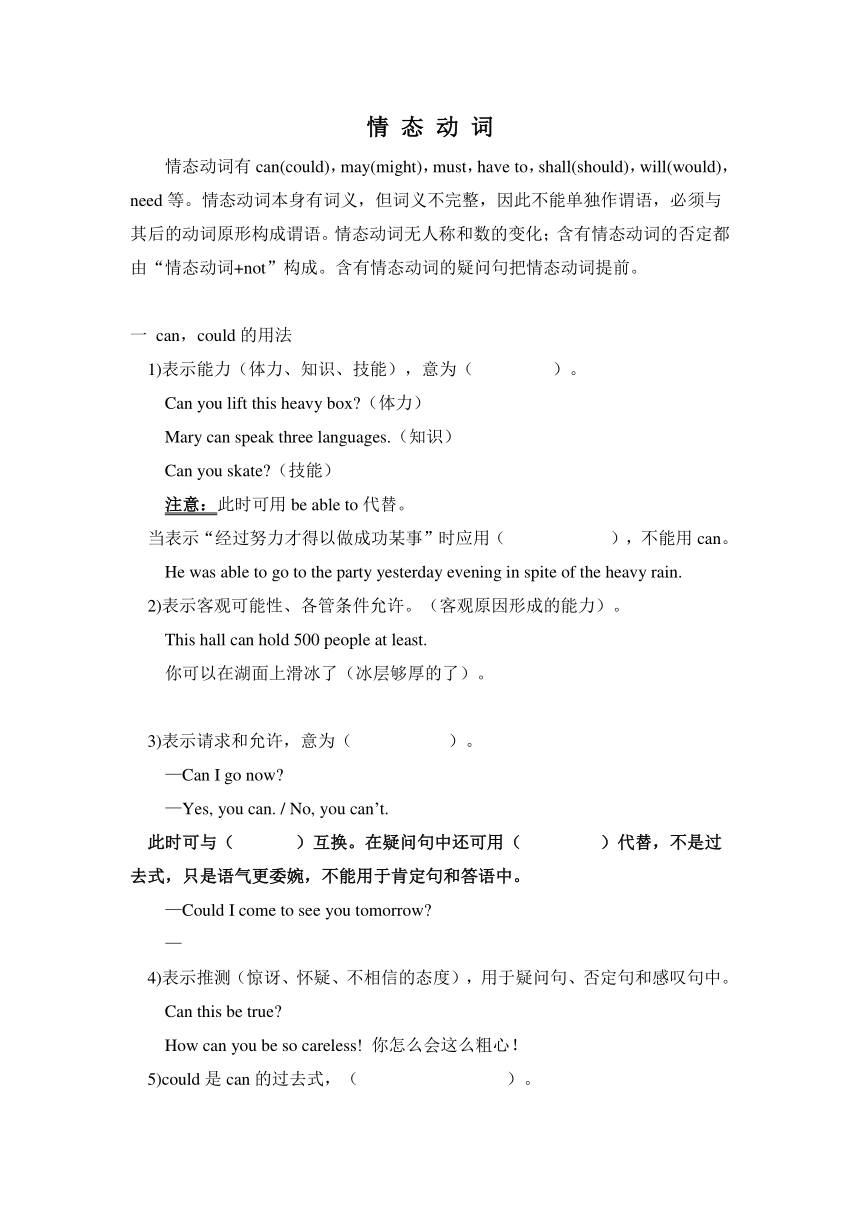
情 态 动 词 情态动词有can(could),may(might),must,have to,shall(should),will(would),need等。情态动词本身有词义,但词义不完整,因此不能单独作谓语,必须与其后的动词原形构成谓语。情态动词无人称和数的变化;含有情态动词的否定都由“情态动词+not”构成。含有情态动词的疑问句把情态动词提前。 一 can,could的用法 1)表示能力(体力、知识、技能),意为( )。 Can you lift this heavy box (体力) Mary can speak three languages.(知识) Can you skate (技能) 注意:此时可用be able to代替。 当表示“经过努力才得以做成功某事”时应用( ),不能用can。 He was able to go to the party yesterday evening in spite of the heavy rain. 2)表示客观可能性、各管条件允许。(客观原因形成的能力)。 This hall can hold 500 people at least. 你可以在湖面上滑冰了(冰层够厚的了)。 3)表示请求和允许,意为( )。 —Can I go now —Yes, you can. / No, you can’t. 此时可与( )互换。在疑问句中还可用( )代替,不是过去式,只是语气更委婉,不能用于肯定句和答语中。 —Could I come to see you tomorrow — 4)表示推测(惊讶、怀疑、不相信的态度),用于疑问句、否定句和感叹句中。 Can this be true How can you be so careless! 你怎么会这么粗心! 5)could是can的过去式,( )。 I could swim when I was seven years. 6)以can开头的一般疑问句,其肯定和否定回答分别用( );以could开头的一般疑问句,其肯定回答和否定回答分别用( )。 —Could you skate last year 你去年会滑冰吗? —Yes, I could. 二 may,might 1)表示请求和允许,意为“可以”。might比may语气更委婉,而不是过去式。在此用法中may和第一人称连用时用一般疑问句,其否定回答用( ),意为( )。不用may not。 —Might/ May I smoke in this room —No, you mustn’t. —May/Might I take this book out of the room —Yes, you can. (No, you can’t / mustn’t. ) 2)用于祈使句,表示祝愿。 May you succeed/success! 祝你成功 ! 3)表示推测、可能性,意为“也许、可能”,用于肯定句(不用于疑问句)。might不是过去式,它所表示的可能性比may小。 He may /might be very busy now. Your mother may /might not know the truth. 三. must,have to 1)表示( )。 You must come in time. 以must开头的疑问句,肯定回答用( );如果是否定的,不能用mustn’t(禁止,不准),而用( )。 —Must we hand in our exercise books today —Yes, you must. —No, you don’t have to / you needn’t. must是说话人的主观看法,而have to(不得不、必须)则强调客观需要。must只有一般现在时,have to有更多的时态形式。 The play isn’t interesting, I really must go now. I had to work when I was your age. 2)表示推测、可能性,( )(只用于肯定的陈述句)。在疑问句和否定句中一般用can,否定句中也可用may,但may not表示“可能不”,而can’t表示“不可能”。 You’re Tom’s good friend, so you must know what he likes best. Your mother must be waiting for you now. 四. need 1) need( )作情态动词用时,常用于疑问句、否定句。在肯定句中一般用must,have to,ought to,should代替。need提问,肯定回答用( ),否定回答用( )。 You needn’t come so early. —Need I finish the work today —Yes, you must. / No, you needn’t. 2) need作实义动词用时,有人称、时态和数的变化。在肯定句中,用助动词提问或否定,need后面接带to的不定式,加doing表被动意义。 He needs to fi ... ...
~~ 您好,已阅读到文档的结尾了 ~~